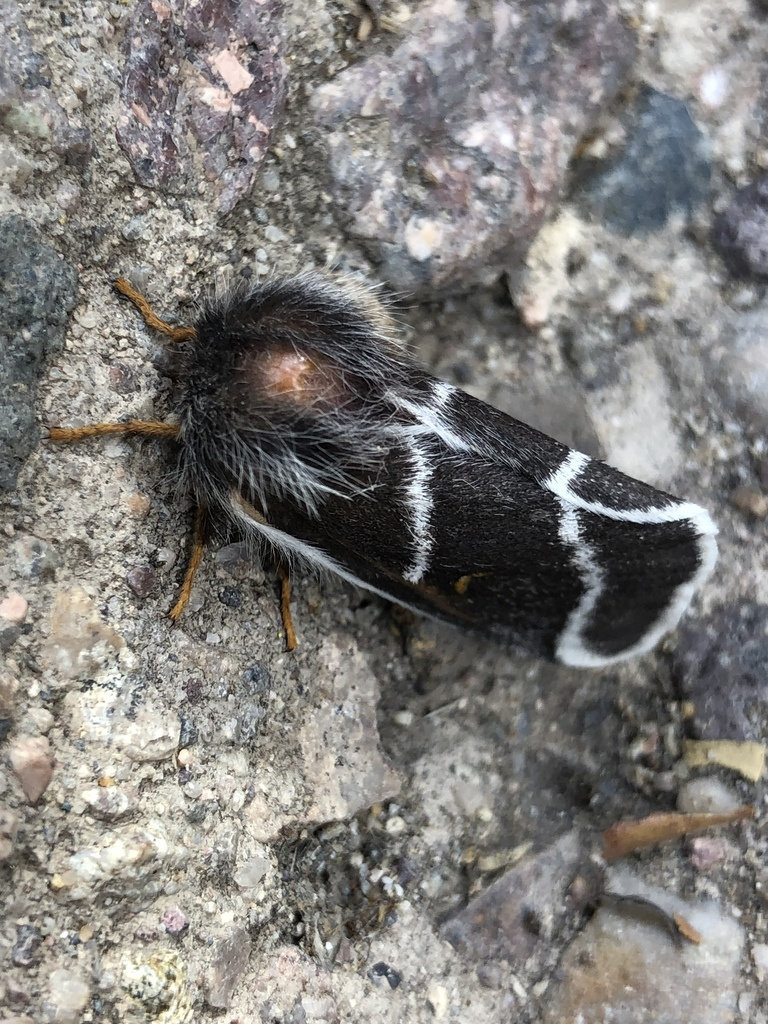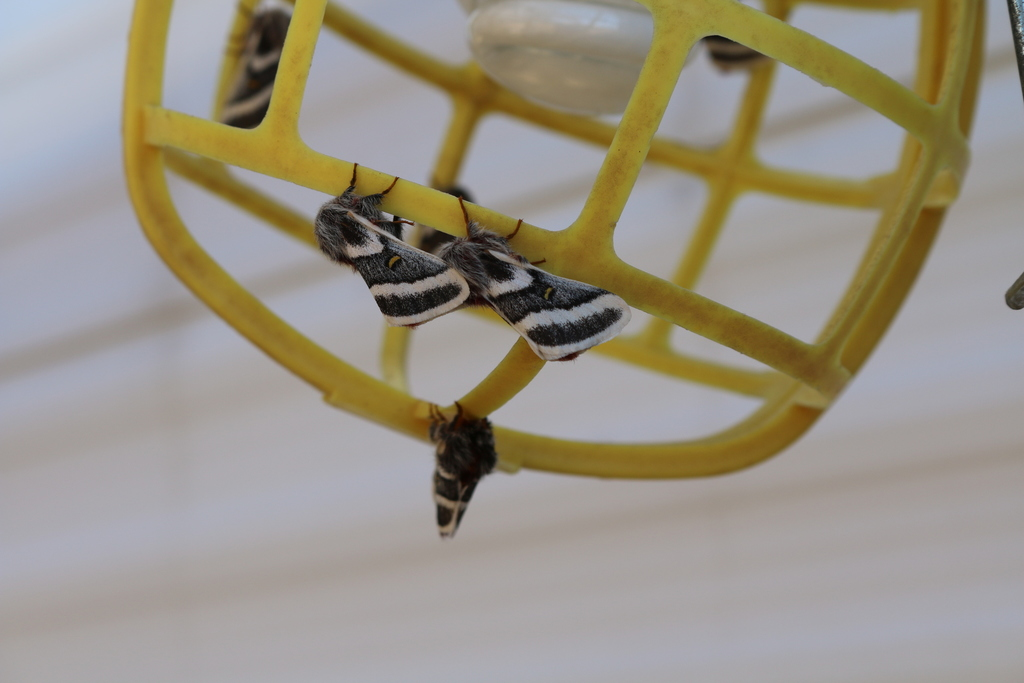With Hemileuca tricolor we come close to the end of the Hemileuca species list. Based on DNA studies alone, Hemileuca vanschayki is a distinct species, but (as with siriae) very little has been written about it; without DNA studies it looks like just another variant of H. eglanterina, and no difference in behavior or habitat has been identified. H. venosa is still sometimes received as a species name but documentation of it online is still limited to lists, no articles or photos. H. washingtonensis has been discussed as a subspecies of H. nuttalli; H. watsoni is now considered a subspecies of H. electra; H. yavapai has been reclassified as a subspecies of H. juno. Not enough material is available to make an article about any of these species, nor do their names appear on a majority of the current lists. So the next and last post about the Hemileucas will be an index.
What follows will depend on you, Gentle Readers. Although only Automeris io is found in Virginia, the genus Automeris is very similar to the genus Hemileuca; there was some disagreement about which genus some species belonged to. There are more species of Automeris than of Hemileuca. Along with all the Automeris species, some species of Coloradia and Saturnia, and especially Lonomia, can be described as stingingworms and, in some ways, resemble the Hemileucas. In the rest of the world, Africa seems to have no native species of caterpillars that sting, but Europe and Asia have a few, and we haven't even considered the slug moth family Those who enjoy caterpillar gross-outs might choose to fund more articles about those moths. Both slug moth caterpillars, many of which sting, and the other silk moth caterpillars, which don't sting but can be very large and bristly, tend to be hard for insect-phobic people to appreciate. The silk moth genus does, after all, include the horned-devils.
Alternatively, you might prefer to fund articles about prettier things. Birds and flowers have been thoroughly covered. Bees and beetles, and the vast number of moths whose caterpillars don't sting, not so much. Or we could move on to some other field of human knowledge. There are enough butterflies to satisfy most readers' interest in fun facts about insects, I'm sure.
Now for the fun facts about Hemileuca tricolor, the Tricolor Buck Moth or Three-Colored Sheep Moth.
Its other distinction is that a higher proportion of the web sites that Google is willing to show, that mention this species, focus on the caterpillar's sting. Its Mexican name is quemador. Some Westerners call them burnworms, as distinct from other stingingworms. Relatively little is available about this species, and though the moths have their admirers, the emphasis seems to be on the fact that "the caterpillars...will sting you something terrible!" (as a Flickr poster put it).
H. tricolor is found in a wide band of land on both sides of the Mexican-US border. Here's a report of its effect on a nature walk in Baja California.
On the US side it's found most often in Arizona and New Mexico, where the caterpillars can get all the paloverde and mesquite they want to eat. They can also eat acacia and mimosa leaves. H. tricolor is listed among wildlife found near Las Vegas, and is sometimes found in Utah and California.
Photo by Astover45. His head looks like a pinhead in a cushion of fur. (Males have feathery antennae; females have hairlike ones.)
Bodies are about an inch long, usually a fraction over one inch. Wingspans range from just over 2 inches to just over 3 inches; females are typically larger than males. The proportions of dark and white speckling in the colored bands on the wings varies. Individuals can look black...
Or pale...
Photo by Salticidude. Females are more likely to show a pinkish or brownish color, males a bluish gray. Hind wings can be relatively light-colored with white margins, or may look plain white.
The upper legs, as well as the thorax, are furry. The abdominal section is also furry with bands of longer hair around its various segments. Under stress, like other Hem,ileucas, the moth tends to curl up and display its most vulnerable area. Possibly it resembles a wasp enough to make this behavior pay, once in a while. It can't sting, and probably doesn't think it can. It has probably formed the habit of curling up from being a caterpillar who was cushioned, when it fell, by landing on its bristles. The fur may be what causes people to describe these moths as "stunningly beautiful," or "tribbles with wings." The moth's fur is not considered venomous, but some say it can be irritating. (Short ends of human hair can also be irritating.)
The life cycle is apparently similar to that of other Hemileucas. Females exude a subtle scent that humans don't notice, but male moths can smell half a mile away. Males race toward a female, who is as eager to unload some eggs as the males are to fertilize them.
Photo by Clara4. The one who dared to get close enough to touch her first is 99.99% sure of being her chosen mate, but the other three (or more) hang around, catching their breath and no doubt hoping the chosen male drops dead. Silk moths typically spend some time cuddling and enjoying each other's company before and after the reproductive act.
However, once the female flits off to lay her eggs, the romance is over; both male and female Hemileucas normally have the ability to mate three times, if they survive long enough, and each time they will ignore prospects of their own age if a younger moth is available. Both sexes release most of their viable gametes in the first mating, because both are unlikely to survive long enough to mate again.
Females lay eggs on a twig of an appropriate plant and hope it will put forth suitable leaves when the caterpillars hatch in spring. Their first few skins are black, and contain relatively little venom. They like to maintain physical contact between bristles, presenting the appearance of a solid mat of thorns to predators. After eating their way through three caterpillar skins they separate; now they eat fast enough that each one needs a leaf of its own.
The final caterpillar skin has rows of branching bristles around the head and tail end and along the lower sides, and a double row of rosette-shaped bristles on the back. The severity of the sting depends on the number of bristle tips that stick in the skin. Rosette-shaped bristles inflict more pain than branching ones, though branching ones are usually enough to remind people to avoid contact with stingingworms.
The inflammation we form on contact with stingingworms is an allergy-type reaction that almost all humans have--some more intensely than others. Anaphylactic shock can occur, but it's rare. Usually pain is confined to the point of contact and fades after bristle tips are removed.
Before the hottest part of the summer the caterpillars hide under dead leaves or sand and pop out of their bristly skins in a smooth pupal shell. The last shed skin is usually near or attached to the end of the pupal shell, and still stings if touched.
Sometimes in autumn like other Hemileucas, but usually in spring (sometimes January--the Sonora Desert doesn't really have winter) the moths hatch out, or eclose, and crawl up onto the ground looking like grubs with only stubs of wings.
Photo by Antrozousamelia. The poor little fellow's wings and antennae are still expanding. He can't yet fly. He thinks exposing his curled abdomen may help him survive. Little does he know that he's safe as if his mother had ever had arms to cradle him in.
They climb up a vertical surface and spend some time pumping haemolymph into their extremities, expanding wings and legs. As the female's wings expand her scent gland starts "calling" males. Before most females test their wings, they mate. After mating they fly for a bit, then lay most of their eggs, then rest for a few hours and, if they can, mate again and lay a few more eggs. Whether or not there is a second mating, fewer eggs will hatch from a moth's second or third brood. Second matings will increase the rate of hatching only slightly.







No comments:
Post a Comment